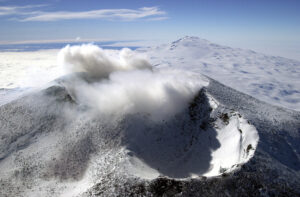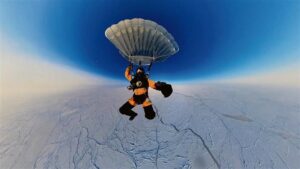In a conversation about the Arctic, British explorer Ranulph Fiennes once commented to me, “Most people aren’t sure whether there are polar bears or penguins up there. It’s all just white to them.”
For the record, there are no penguins in the Arctic. There are, however, polar bears. This makes arctic travel significantly different from the Antarctic variety. Both places are cold, hard to get to and may require pulling sleds for hundreds of kilometres. But it’s hard to run afoul of wildlife on the Southern Continent. Not so the Arctic.
During my travels, which add up to about four years in a tent in the Arctic, I’ve had 13 close calls with polar bears. The precise number reflects the fact that you never forget one of these encounters, any more than you’d lose track of number of avalanches you’ve survived. I’ve never killed a bear, and a bear, obviously, has never killed me. But at times, it’s been close for both of us.
I don’t consider these encounters attacks. My head was never in a bear’s jaws, which happened to a hiker in Labrador some years ago. No polar bear has ever charged me, even as a bluff. Mostly, these close calls have involved a bear breaking into my tent or sled, or approaching me as potential prey. Usually, the bears were not sure if I qualified. I didn’t look or behave like a ring seal. But predators are opportunists, and they were testing the waters. Depending on my response, the situation could easily escalate into an attack. Most of these incidents were also with adolescent males, which like their human counterparts, are cocky, aggressive and have a lot to learn about how the world works.

Inspecting the damage after a polar bear break-in, Ellesmere Island. Photo: Jerry Kobalenko
Some of the 13 were nightmarish. The first one was particularly traumatic, and it took me years before I could sleep well on an arctic expedition again. Luckily, several years passed between the first encounter and the second, which gave me time to heal. By the time the second incident occurred, I seemed able to recover promptly.
Others of the 13 were almost comical. A curious polar bear approached my partner and I upwind in long, lazy zigzags as we sledded, gradually drawing within 30m. By then, we had stopped sledding, extracted ourselves from our skis and harnesses, and were waiting for it, guns and other deterrents at the ready. Finally, we yelled, “F*** off!” It did.
We were quite pleased with ourselves. But rather than stand around, laughing and joking, as we had done after a similar encounter a couple of years earlier, we immediately resumed our businesslike sledding, as if to let the withdrawing bear know that we considered it so insignificant, the encounter didn’t merit any deconstruction.
This sounds weird and anthropomorphic, I know, but on that earlier occasion, something about our behavior — our human voices, our laughter, something we were doing wrong — convinced the bear that we weren’t as intimidating as we’d first seemed. It stopped retreating, wheeled around and began beelining for us from about 200m away. Further noise, warning shots, flares, didn’t deter it or even make it hesitate. It had decided that we were bluffing.
We had two high-powered firearms in our hands, and a polar bear, powerful though it is, almost always loses in such a clash. My main fear was that we’d have to shoot it to make it stop. This is not only a tragedy and a failure, but it creates a lot of red tape and bad feelings with the nearest Inuit community. They are allowed to hunt only a small number of bears a year, to sell the skins, or for a young Inuit man’s rite of passage, or to transfer the permit to a southern hunter for tens of thousands of dollars. A defence kill comes out of their modest quota, and they understandably don’t like it.
Over the years, some defence kills have occurred because adventurers let the bears approach too closely for photos. Although I’m a serious photographer, I have few good shots of polar bears, because whenever they’ve been close enough for photos, I’m too focused on defusing the encounter. There are only so many objects you can hold in your hands at one time. Around polar bears, I hold deterrents. Almost all my best polar bear photos have come when I lecture on arctic cruise ships and I can photograph from the safety of a Zodiac or from the deck of a 137m-long vessel.

Polar bear encounters are jolly, when experienced from a 5,000-ton iron ship. Photos: Jerry Kobalenko
But now, we were hundreds of kilometres from the nearest person. As I ran through my various deterrents, my partner kept his rifle trained on the bear. Polar bears tend not to charge but simply walk at you, head lowered, beady black eyes boring into you with predatory focus. But they can charge, and suddenly, a slow train is barreling toward you at space-capsule speed.
You never need to shoot a polar bear from 40m or 50m away, but sometimes you have to resist the temptation, because the tension in these encounters is excruciating. Usually, my line in the sand is 10m: By then, I’ve likely exhausted all my non-lethal deterrents. At 10m, I am prepared to fire. You have to rehearse this in your head ahead of time, because it’s a terrible decision to make, and you can’t hesitate. If you travel the Arctic, you must accept that you may have to kill a polar bear. If you can’t commit to this, and believe that polar bears are fluffy symbols of climate change or stars of Coke commercials, then this sort of travel is not for you.
But 10m is just a rule of thumb, and this bear was coming fast, with none of the willingness to be deterred that others usually show. We’d already tried everything and decided to fire from about 20m away. In an incredible stroke of good luck, my partner, whom we agreed would fire first, just nicked the bear. It reacted as if it had been stung by a hornet, turned and hurried away. It wasn’t limping or in any apparent distress. We later found a silver-dollar-sized piece of fur on the snow: The bullet had just grazed it. We’d all been lucky.
Although 13 incidents sounds like a lot, it’s not enough to draw firm conclusions about bear behavior. I still don’t know what caused that polar bear to decide, after its initial withdrawal, that we were bluffing. The human voice? Our laughter? Nevertheless, that one traumatic incident gave us a theory, and after we’d yelled at that second bear a couple of years later, we didn’t speak or laugh but quickly resumed sledding. That bear didn’t reverse course; maybe thanks to our theory, maybe not.
I’ve amended my behavior in other ways, too. Sometimes, a shout scares the polar bear away. But twice, I’ve shouted at nearby polar bears from inside the tent, where they couldn’t see me, and the bears became even more interested. In one case, I had to shoot a hole through the tent with my shotgun to scare the bear, which had begun to push against the nylon wall. Theory: If the bear doesn’t see the source of the noise, you risk worsening matters. Again, two episodes are not statistically significant, and my theory is unproven, but I’ll never shout at a polar bear from inside a tent again.

Even travelers who have never hunted must carry a firearm and know how to use it. Photo: Jerry Kobalenko
So what do you do? What do you bring?
The first and most important item is a firearm, usually a 12-gauge shotgun with one-ounce slugs. Foreigners coming to Canada have to jump through hoops to bring a firearm into this country, but it’s not too hard: Many international hunters visit Canada, and there is a procedure in place. Canadian citizens take a course and get a permit that allows us to buy and possess a firearm. You even need to present this card every time you buy ammunition.
It would be convenient to carry a .44 magnum handgun — the Dirty Harry calibre that is strong enough for a polar bear — especially sea kayaking, where it could sit handy in a waterproof case on deck, and backpacking, because it weighs less than half what a shotgun does. But unlike the U.S., it is very difficult in Canada to get permission to carry a handgun, even in the wilderness.
A firearm is two things: the first line of defence, in the form of a warning shot, and the last line of defence, which you hope you will never use. Everyone — scientists, Inuit, guides, tourists like myself — carries a gun in polar bear country. It is unsafe to travel without one. The Arctic is the only place in the world where, if the local police ask if you have a gun and you say yes, they visibly relax.
The one-ounce slug is the stopper and noisemaker. Some travelers also like to carry bear bangers and rubber bullets. A bear banger is a 12-gauge shell that loads into the shotgun like ordinary ammo. It fires with a little pop (and no recoil), flies 30m or so, then explodes with a loud bang directly in front of the bear. A rubber bullet is a non-lethal round made of plastic or rubber that stings even the tough hide of a polar bear. Unless you fire at point blank range, it does not penetrate. I carry rubber bullets but tend not to use them. I don’t like fiddling with different rounds in the shotgun, and I prefer another deterrent. Bear bangers and rubber bullets are available at some places in Canada. You also need a firearms permit to buy this sort of ammunition.
Bear spray is handy on summer expeditions but does not work well at -40° or -50°C. The spray just comes out as big blobs and falls immediately to the snow. Years ago, an arctic biologist tested bear spray in the cold on a polar bear. It didn’t work, and the bear seemed to enjoy licking up the spray from the snow.

Skyblazer flares. Photo: Jerry Kobalenko
My go-to deterrent is aerial flares. Typically used as marine distress signals, they fire a rocket high in the air — or you can fire them in front of the bear. Projectiles don’t exist in nature and are very disturbing to wildlife. Polar bears also don’t like the hissing or the fire and smoke. Most of my polar bear encounters have ended happily, thanks to these flares.
Some polar bears take more than one flare to deter — one took seven! — so I do not use common pen flares. With these, you have to take your eye from the bear after every round to unscrew the spent cartridge and screw on a new one. Instead, I use Skyblazers, which fire by pulling a tampon-like string. Depending on the local bear population, I will bring 15 to 30 of these flares on an expedition. I keep them in every pocket, and have several ready in the tent at night.
These flares have disadvantages. First, they are only safe on snow or tundra. The burning magnesium is so hot that in the brushy subarctic, you risk starting forest fires if you fire them at the ground. For the same reason, they are not suitable for grizzlies.
Second, it is very hard to get them into Canada, and still harder to get them north. They’re made in the U.S., and even a bonded courier can’t take them across the border. (I got mine directly from the Canadian distributor of the company’s other products.) Within Canada, you can’t fly with them and must ship them ahead of time on a cargo-only airplane. This is easy as far as Iqaluit, the capital of Nunavut; from there, it can take months to get them to the little arctic hamlet where you plan to start your trek. Organizing an arctic journey is often harder than the expedition itself, but it is usually possible to find a solution.

A lightweight alarm fence encircles a camp on frozen Jones Sound, between Ellesmere and Devon Islands. Photo: Jerry Kobalenko
The worst incidents almost always take place at night. A polar bear smells your camp — it’s said that a polar bear can smell a seal breathing hole under the snow from 10km away — and investigates. Encountering no resistance from sleeping campers, it gradually becomes bolder. After working hard all day traveling, you feel that it is very unfair to be woken up in a survival situation.
I didn’t use an alarm fence for years, until the number of nocturnal encounters became simply too irritating. Instead, I resorted to the ploy of putting my sled, with all the food, 20m or 30m in front of the tent, in the direction from which a polar bear would likely approach. This bought me time. Indeed, the polar bear usually broke into the sled first, before it reached the tent. I’d hear the noise and chase the bear away with a flare or two.
Over the years, I have also learned to sleep with one ear open. What does this mean? Every sleeper half wakes up now and then, then rolls over and goes back to sleep. We think nothing of it. But out there, you have to ask: Why did I wake up? Did I hear something? So before going back to sleep, I lie quietly for about 10 minutes, listening. On two occasions, I heard a follow-up noise. Shit: a polar bear. I did wake up for a reason.
Some years ago, I did start using a bear fence. Electrified fences that shock an animal are far too heavy and time-consuming to set up. They are used only at base camps. Instead, a single-wire fence encircles the camp and leads to an alarm in the tent. The perimeter wire stretches over lightweight carbon poles and is pre-cut in several places, and the sections are held together lightly with small banana plugs.
When an animal walks through the fence and breaks the circuit, a loud alarm goes off. This may scare the bear away, but its main function is to wake you up. The entire assembly — poles, wire, battery, alarm unit — weighs just 1.5kg. It takes about half an hour to set up every night. Further information here.

Various homemade alarm units for a polar bear fence. If you live in the U.S., good luck getting these suspicious devices past airport security. Here, the writing and crude logos attempt to explain or “cute-ify” the device during any potential inspection. Photo: Jerry Kobalenko
As wildernesses go, the Arctic is surprisingly benign. Cold is not dangerous; it’s actually easy to deal with. But the polar bear is the one true source of objective danger. Most polar bears aren’t interested in you: They’ll run away or ignore you. But once in a while, an individual bear will not. They are the four-footed avalanches of the North.






